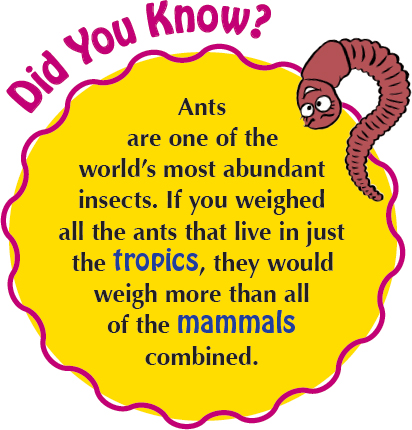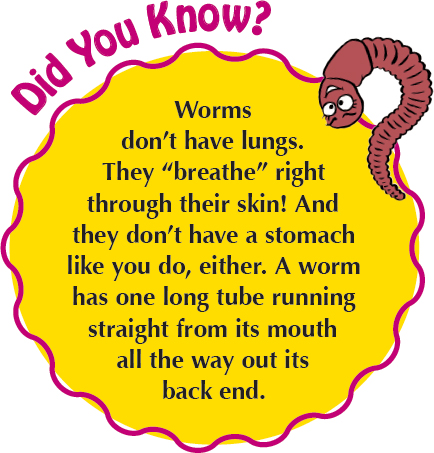
At first glance, soil looks like just a blanket of rock particles and humus covering the surface of the earth. But there’s more to soil than you think! It’s home to all kinds of living things. In fact, in one teaspoon of soil, there can be billions of microbes, plus many different insects!
Have you noticed the earthworms that live in the soil? Earthworms are perfectly suited to their life there. When they wiggle through the soil, earthworms make tiny tunnels that help let in air and water. But they also move soil around, mixing and moving the nutrients. They eat tiny bits of dead leaves and other organic materials, breaking it down even more so plants can use it.
ESSENTIAL QUESTION
What does soil provide for the organisms that live in it?

Insects live in the soil, too. There are about 950,000 species of insects on the planet, and many of those live right in the soil. Ants and termites rule the underground world. Some other soil-dwelling insects include potato bugs, woodlice, millipedes, beetles, slugs, snails, and mites.
The fungi and bacteria that live in soil do similar jobs—they help break down organic materials into soil. But they are different in a couple of ways. Bacteria are usually smaller in size, but there are more bacteria than fungi. And bacteria are made up of one cell. Most fungi are made of many cells. What about you? Are you made of one cell or many cells?
WORDS to KNOW
microbe: a tiny living or nonliving thing. Bacteria and fungi are living microbes that are also called microorganisms.
species: a group of plants or animals that are related and look like each other.
cell: the smallest, most basic part of a living thing.
tropics: the area near the equator. This is the imaginary line around the earth halfway between the North and South Poles.
mammal: a warmblooded animal, such as a human, dog, or cat, that can keep itself warm. Mammals feed milk to their young and usually have hair or fur covering most of their skin.

Larger creatures live in the soil, too, including moles. Moles live underground all the time, and they are perfectly made for it. They have tiny eyes, velvety fur, and big, flipper-like paws to dig and push at the earth. They eat earthworms and grubs. Other creatures, such as prairie dogs and chipmunks, make their homes underground but come above ground to find food.
SOIL AND PH
Different parts of the planet have different kinds of rocks, organisms, landscapes, and weather conditions. This means that the soil in different parts of the world is different.
Not all organisms can live in all types of soil. Some organisms need soil that is acidic and some organisms need soil that is basic.
Different substances are made of different chemicals. Scientists look at how a substance interacts with water to figure out how acidic it is.
WORDS to KNOW
landscape: a large area of land with specific features.
acidic: describes a substance that is low on the pH scale and loses hydrogen in water. Examples of acidic substances include lemon juice and vinegar.
basic: describes a substance that is high on the pH scale and gains hydrogen in water. Examples of basic substances include soap, baking soda, and ammonia.
chemical: the pure form of a substance. It has certain features that can react with other substances. Some chemicals can be combined or broken up to create new chemicals.
Water is made up of hydrogen and oxygen. If a substance interacts with water and produces more hydrogen, it’s considered to be an acid. Substances are measured by a scale to show how acidic or basic they are. The scale goes from 1 to 14 and uses a measurement called PH.
WORDS to KNOW
hydrogen: the most common element in the universe. Hydrogen and oxygen are the two elements in water.
element: a pure substance that can’t be broken down, such as hydrogen, oxygen, carbon, or gold.
PH: the scale people use to measure how acidic or basic something is.
Substances measuring between 1 and 7 on the pH scale are acidic. They have a low pH. Substances that measure between 7 and 14 are basic. They have a high pH. Pure water is neutral and has a pH of 7, right in the middle.

WHICH PH FOR PLANTS?
Most plants do best in slightly acidic soil that has a pH between 5 and 7. But some plants, such as blueberries, do well in more acidic soil with a pH between 4 and 5. Other plants, such as cactuses, prefer to grow in soil that’s higher on the pH scale. A pH of higher than 7 is called basic or alkaline.


Everything, even you, is made up of matter. Matter is made of tiny particles called atoms. When atoms join together, they form clusters called molecules. Imagine that atoms are like letters and molecules are like words. A group of atoms joins together to make a molecule just like a group of letters joins together to make a word.
An element is a substance that’s made of just one type of atom. Gold, hydrogen, and oxygen are all examples of elements. Sometimes atoms from different elements combine to make compounds. Water is a compound made of hydrogen and oxygen atoms.

KEYWORD PROMPTS
kids periodic table 
Soil is measured on this scale, too. Why is it important to know the pH of soil? Because different plants are adapted to using different nutrients and chemicals in the soil. Also, the bacteria that help the plants grow thrive in different pH levels, too.
Soil is an amazing resource that most people don’t think about very often. In this book, you’ll learn why soil is so important to our planet. Let’s explore the dangers our soil faces and how you can help keep it healthy!
ESSENTIAL QUESTION
Now it’s time to consider and discuss the Essential Question: What does soil provide for the organisms that live in it?
WORM COMPOSTING
Earthworms have an important job recycling organic material into soil. You can watch earthworms at work with this simple worm composting jar!
CAUTION: An adult needs to help with the hammer and nail.
SUPPLIES
 quart-sized canning jar with lid
quart-sized canning jar with lid
 soil
soil
 nail
nail
 hammer
hammer
 worms
worms
 food scraps
food scraps
 dark construction paper
dark construction paper
 tape
tape
WORDS to KNOW
composting: recycling food scraps to form humus for the soil.
1 Scoop some soil into your jar. Don’t pack it in tightly! The worms need room to do their work! Leave a couple of inches of space at the top of the jar. Make sure the soil is slightly damp but not completely soaked with water.
2 Have an adult poke holes in the lid of the jar with a hammer and nail. Set it aside.
3 Dig for some worms outside. You only need two or three, because there isn’t a lot of space in your jar. Put the worms in your jar.

4 Once the worms have slithered down into the soil a little, add some food scraps to the jar. Only add things that are natural—no junk food! Tiny pieces of apple, carrot, and other types of fruit and vegetables are good worm food. You can also add small amounts of used tea leaves or coffee grounds.

5 Put the lid on your jar and wrap the whole thing with the dark construction paper. This will give the worms the darkness they like so they’ll get to work. Every few days, come back and check on your worms. Are they breaking down the food material?
6 Release the worms back outside when you’re finished with this project. You can use the rich, composted soil for a plant!
THINK ABOUT IT: Did your soil change color, texture, or smell while the worms lived in it? How did it change? Why do you think gardeners use worms for composting?

WHAT DO YOU CALL IT WHEN WORMS TAKE OVER THE WORLD?
Global worming!
BERLESE FUNNEL
Sneak a peek into the living world of soil! Using this funnel, sometimes called a Tullgren funnel, you can see what tiny organisms are living in a sample of soil.
SUPPLIES
 black construction paper
black construction paper
 large jar
large jar
 tape
tape
 funnel
funnel
 small piece of mesh from an old screen or strainer
small piece of mesh from an old screen or strainer
 soil or leaf litter
soil or leaf litter
 desk lamp
desk lamp
 magnifying glass or microscope
magnifying glass or microscope
1 Secure the black construction paper around the jar with tape. Set the funnel into the top of the jar.
2 Fit the small piece of mesh in the bottom of the funnel to prevent soil from falling through into your jar. Fill the funnel loosely with fresh soil.
3 Set the desk lamp so that it shines down directly on the soil in the funnel. Keep it just far enough away so it doesn’t burn the soil. Soil creatures like cool darkness, so they’ll move away from the light and heat.
4 Wait an hour and then take the construction paper off your jar. Are there any creatures in your jar? Use your magnifying glass or microscope to examine them. Release the creatures when you’re done.
TRY THIS! Fill your Berlese funnel with soil from a different location. Try using leaf litter found at the bottom of a pile of leaves. Do the creatures you see look different? Do they behave differently? Why might different creatures thrive in different types of soil?
